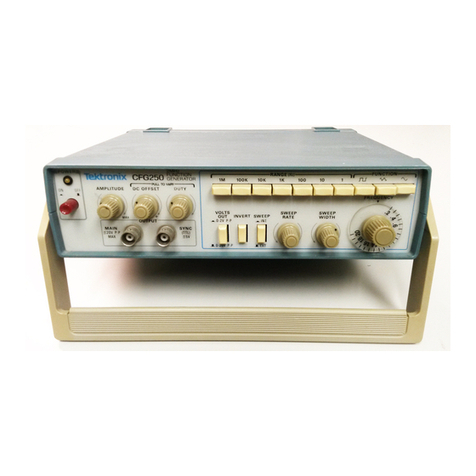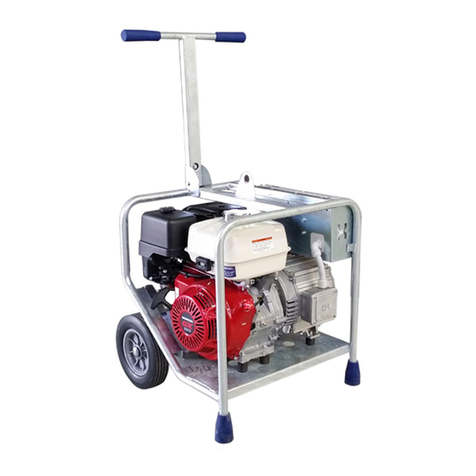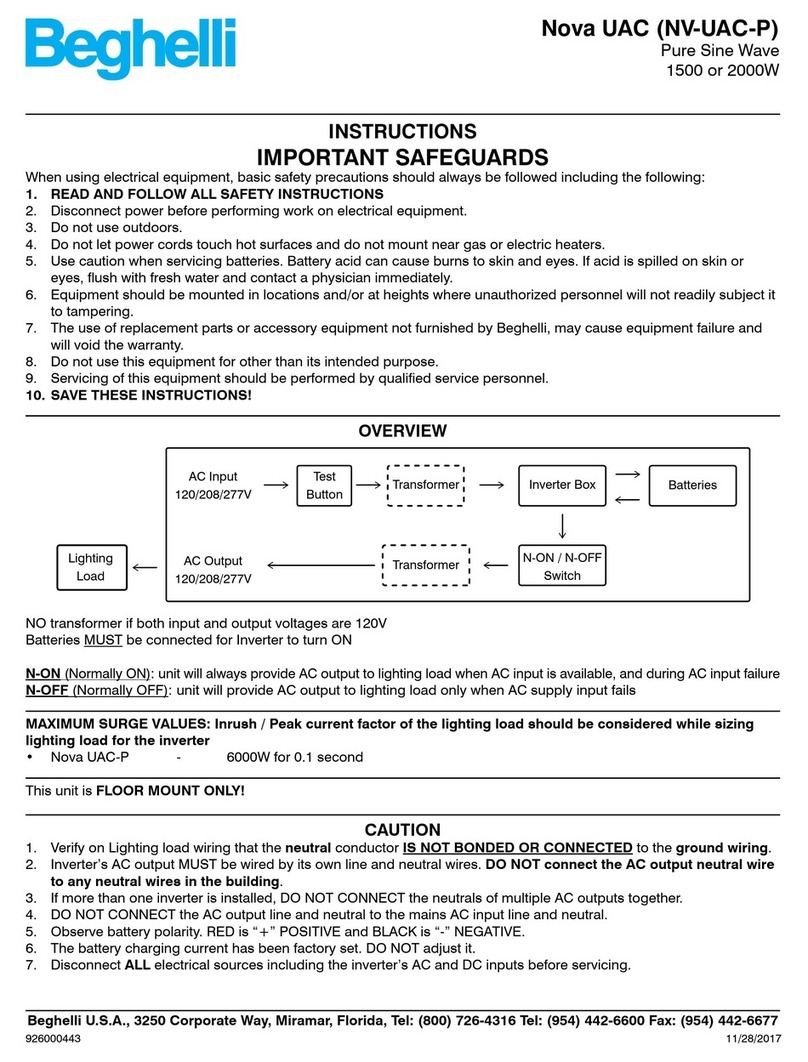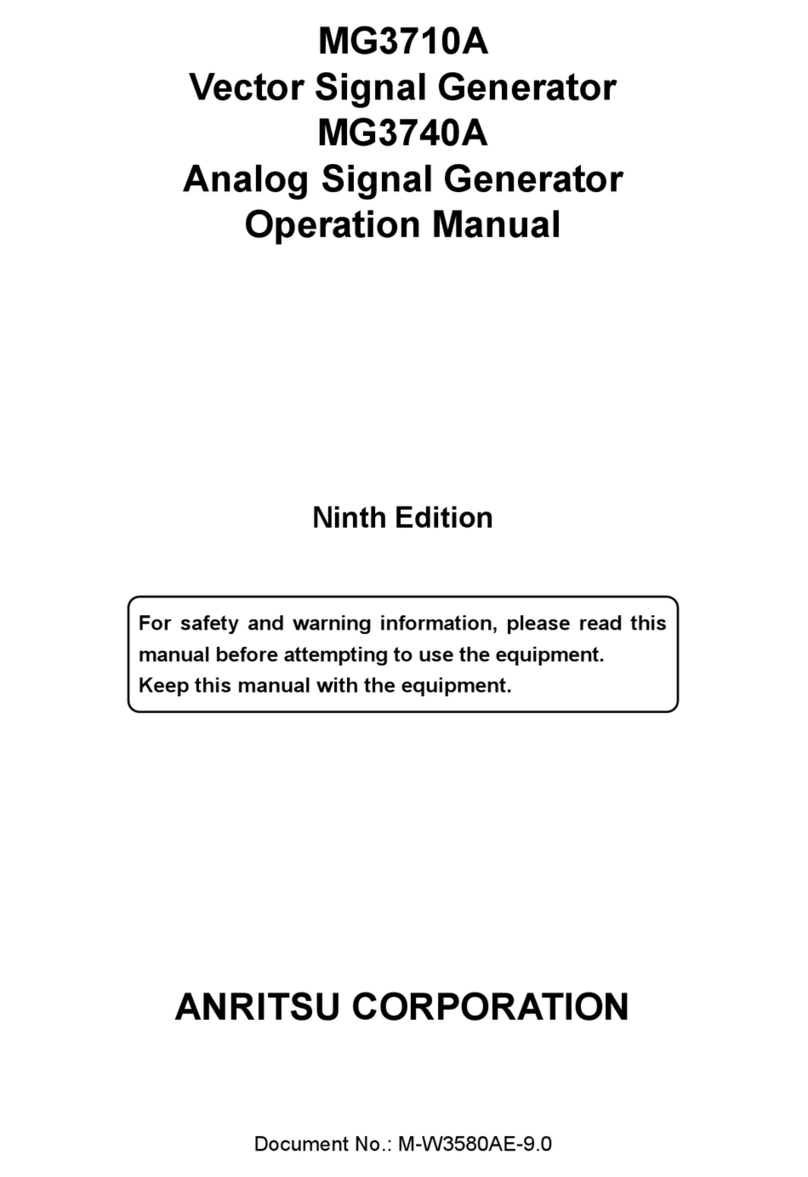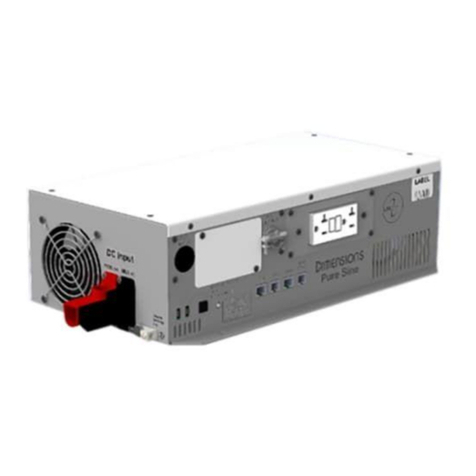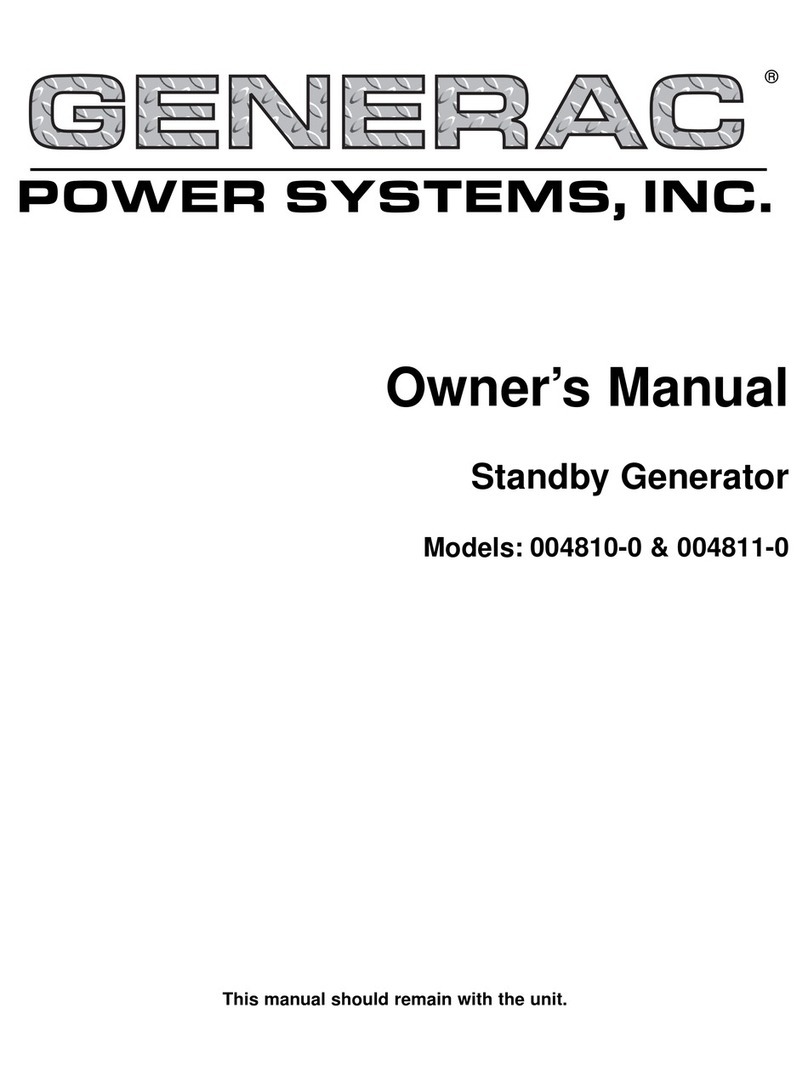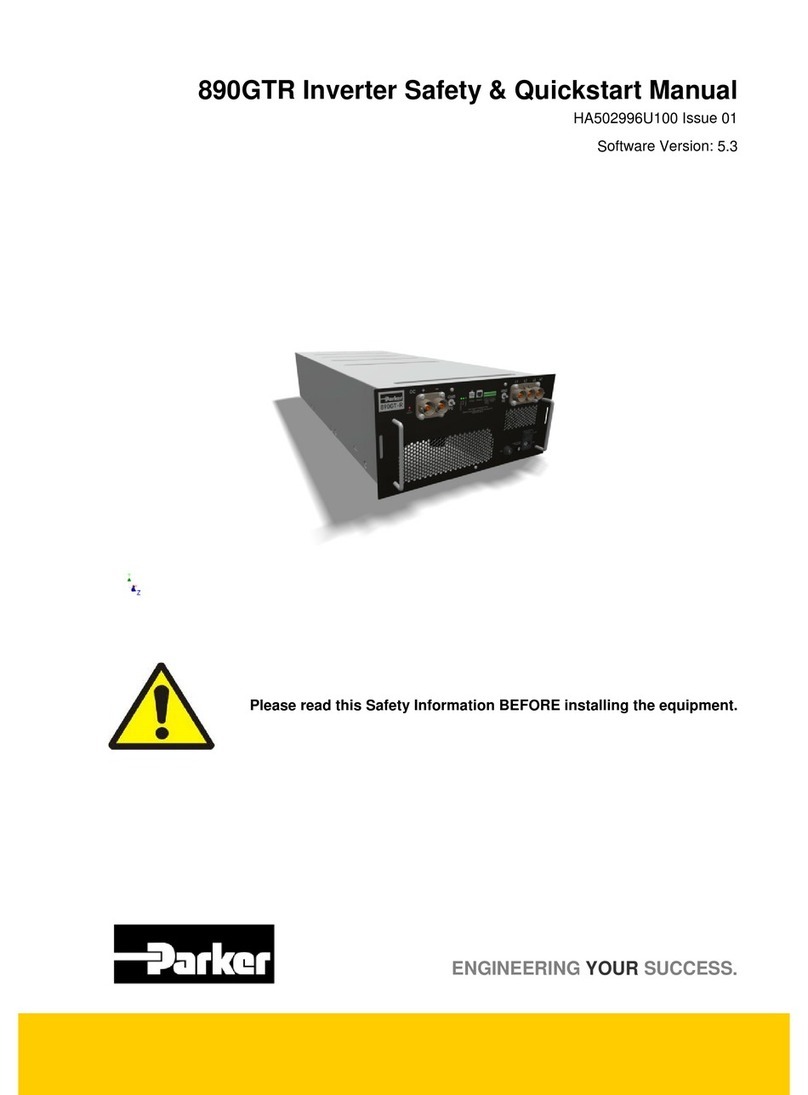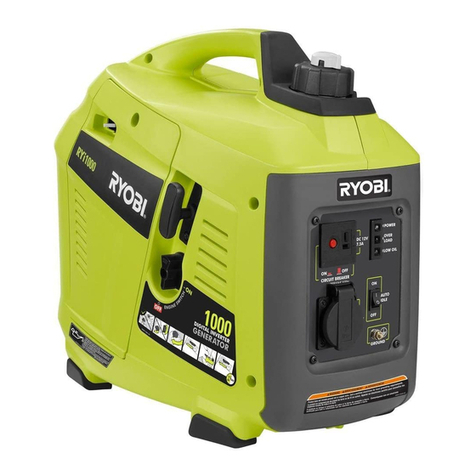Devel XPT Series User manual

- 1 -
XPT Series Pure Sine Wave Inverter
For All Home & Office Appliances
User’s Manual
Version 1.0
Utility + Inverter + Charger + Transfer SW + Solar Power + AGS
All in One

- 2 -
Table of Contents
1. Important Safety Information ........................................................................................................................3
1-1. General Safety Precautions.........................................................................................................................3
1-2. Precautions When Working with Batteries ................................................................................................3
2. Introduction....................................................................................................................................................5
2.1. General Information....................................................................................................................................5
2.2. Application..................................................................................................................................................5
2.3. Features.......................................................................................................................................................6
2.4 Electrical Performance.................................................................................................................................6
2.4.1 Inverter...............................................................................................................................................7
2.4.2 AC Charger ........................................................................................................................................7
2.4.3 Transfer ..............................................................................................................................................9
2.4.4 Auto frequency adjust ........................................................................................................................9
2.4.5 Solar Charger ...................................................................................................................................10
2.4.6 Automatic Voltage Regulation ........................................................................................................11
2.4.7 Power Saver .....................................................................................................................................12
2.4.8 Protections........................................................................................................................................14
2.4.9 Remote control.................................................................................................................................14
2.4.10 LED Indicator & LCD ...................................................................................................................15
2.4.11 Audible Alarm ...............................................................................................................................16
2.4.12 FAN Operation...............................................................................................................................16
2.4.13 DIP Switches..................................................................................................................................17
2.4.14 Output Socket.................................................................................................................................17
2.4.15 Other features.................................................................................................................................18
3 Installation.....................................................................................................................................................19
3.1 Location ..............................................................................................................................................19
3.2 DC Wiring recommendation...............................................................................................................19
3.3 AC Wiring...........................................................................................................................................19
4 Troubleshooting Guide .................................................................................................................................21
5 Warranty .......................................................................................................................................................24
6 Order Information .........................................................................................................................................28
Appendix 1.......................................................................................................................................................26

- 3 -
1.ImportantSafetyInformation
WARNING!
This manual contains important instructions for all XPT Inverter/Charger models that
shall be followed during installation and maintenance of the inverter.
1‐1.GeneralSafetyPrecautions
1. Before installing and using the XPT Inverter/Charger, read all instructions and cautionary markings on the
XPT Inverter /Charger and all appropriate sections of this guide. Be sure to read all instructions and
cautionary markings for any equipment attached to this unit.
2. This unit is designed for indoor use only. Do not expose the XPT Inverter/Charger to rain, snow, or spray.
3. To reduce risk of fire hazard, do not cover or obstruct the ventilation openings. Do not install the XPT
Inverter/Charger in a zero-clearance compartment. Overheating may result.
4. Use only attachments recommended or sold by the manufacturer. Doing otherwise may result in a risk of
fire, electric shock, or injury to persons.
5. To avoid a risk of fire and electric shock, make sure that existing wiring is in good condition and that wire
is not undersized. Do not operate the XPT Inverter/Charger with damaged or substandard wiring.
6. Do not operate the XPT Inverter/Charger if it has received a sharp blow, been dropped, or otherwise
damaged in any way. If the XPT Inverter/Charger is damaged, see the Warranty section.
7. Do not disassemble the Inverter/Charger. It contains no user-serviceable parts. See Warranty for
instructions on obtaining service. Attempting to service the XPT Inverter/Charger yourself may result in a
risk of electrical shock or fire. Internal capacitors remain charged after all power is disconnected.
8. The XPT Inverter contains more than one live circuit (batteries and AC line). Power may be present at
more than one source. To reduce the risk of electrical shock, disconnect both AC and DC power from the
XPT Inverter/Charger before attempting any maintenance or cleaning or working on any circuits connected
to the XPT Inverter/Charger. Turning off controls will not reduce this risk.
9. Use insulated tools to reduce the chance of short-circuits when installing or working with the inverter, the
batteries, or PV array.
1‐2.PrecautionsWhenWorkingwithBatteries
1. Make sure the area around the battery is well ventilated.
2. Never smoke or allow a spark or flame near the engine or batteries.
3. Use caution to reduce the risk or dropping a metal tool on the battery. It could spark or short circuit the
battery or other electrical parts and could cause an explosion.
4. Remove all metal items, like rings, brace lets, and watches when working with lead-acid batteries.
Lead-acid batteries produce a short circuit current high enough to weld metal to skin, causing a severe
burn.
5. Have someone within range of your voice or close enough to come to your aid when you work near a
lead-acid battery.
6. Have plenty of fresh water and soap near by in case battery acid contacts skin, clothing, or eyes.
7. Wear complete eye protection and clothing protection. Avoid touching your eyes while working near

- 4 -
batteries.
8. If battery acid contacts skin or clot hing, wash immediately with soap and water. If acid enters your eye,
immediately flood it with running cold water for at least twenty minutes and get medical attention
immediately.
9. If you need to remove a battery, always remove the grounded terminal from the battery first. Make sure all
accessories are off so you don’t cause a spark.
10. Always use identical types of batteries.
11. Never install old or untested batteries. Check each battery’s date code or label to ensure age and type.
12. Batteries are temperature sensitive. For optimum performance, the should be installed in a stable
temperature environment.
13. Always recycle old batteries. Contact your local recycling center for proper disposal information.

- 5 -
2.Introduction
2-1. General Information
Thank you for purchasing the XPT Series Inverter/Charger.
XPT Series Pure Sine Wave Inverter is a combination of an inverter, charger, solar power and Auto-transfer
switch into one complete system . It is packed with unique features and it is one of the most advanced
inverter/chargers in the market today.
The inverter features an AC pass-through circuit, powering your home appliances from utility or generator
power while charging the battery. When utility power fails, the battery backup system keeps your appliances
powered until utility power is restored. Internal protection circuits prevent over-discharge of the batteries by
shutting down the inverter when a low battery condition occurs. When utility or generator power is restored,
the inverter transfers to the AC source and recharges the batteries.
Accessories allow the XPT series to also serve as a central hub of a renewable energy system. Set the XPT
Series inverter to battery priority mode, designates the inverter-preferred UPS configuration. In this
configuration, the load power in normally provided by the inverter. However, if the inverter output is
interrupted, an internal transfer switch automatically transfers the load from the inverter to commercial AC
power. The transfer time between inverter and line is short(6ms typical), and such transfers are normally not
detected by even highly sensitive loads. Upon restoration of inverter power, the inverter will transfer back to
inverter power.
On the line priority mode, when utility AC power cuts off(or falls out of acceptable range), the transfer relay
is de-energized and the load is automatically transferred to the Inverter output. Once the qualified AC utility
is restored, the relay is energized and the load is automatically reconnected to AC utility.
It features power factor corrected, sophisticated multi-stage charging and pure sine wave output with
unprecedentedly high surge capability to meet demanding power needs of inductive loads without
endangering the equipment.
XPT Series Inverter is equipped with a powerful charger of up to 120Amp (depending on Model). The
overload capacity is 300% of continuous output for up to 20 seconds to reliably support tools and equipment
longer
Another important feature is that the inverter can be easily customized to Battery priority via a DIP switch,
this helps to extract maximum power from battery in renewable energy systems. Thus, the XPT Series Pure
Sine Wave Inverter is suitable for Renewable energy system, Utility, RV, Marine and Emergency
appliances.
To get the most out of the power inverter, it must be installed, used and maintained properly. Please read the
instructions in this manual before installing and operating.
2-2. Application
Power tools–circular saws, drills, grinders, sanders, buffers, weed and hedge trimmers, air compressors.
Office equipment – computers, printers, monitors, facsimile machines, scanners.

- 6 -
Household items – vacuum cleaners, fans, fluorescent and incandescent lights, shavers, sewing machines.
Kitchen appliances – coffee makers, blenders, ice markers, toasters.
Industrial equipment – metal halide lamp, high – pressure sodium lamp.
Home entertainment electronics – television, VCRs, video games, stereos, musical instruments, satellite
equipment.
2.3Features
SmartRemoteControl(RMT)
BatteryTemperatureSensor(BTS)
AutomaticGeneratorStarting(AGS)
SupportSolarPanelwithMPPTFunction
DesignedtoOperateunderHarshEnvironment
DCStart&AutomaticSelf-DiagnosticFunction
CompatiblewithBothLinear&Non-LinearLoad
EasytoInstall&EasytoOperate&EasytoSolve
LowDCVoltageSupportsHome&OfficeAppliances
PowerfulChargeRateUpto120Amp,SelectableFrom0%-100%
HighEfficiencyDesign& “PowerSavingMode” toConserveEnergy
BatteryPriorityMode,DesignatestheInverter-PreferredUPSConfiguration
13VdcBatteryRecoverPoint,DedicatedforRenewableEnergySystems
8preSetBatteryTypeSelectorplusDe-sulphationforTotallyFlatBatteries
4-stepIntelligentBatteryCharging,PFC(PowerFactorCorrection)forCharger
8msTypicalTransferTimeBetweenUtility&Battery,GuaranteesPowerContinuity
15sDelayBeforeTransferwhenACResumes,ProtectionforLoadwhenUsedwithGenerator
2.4ElectricalPerformance

- 7 -
2.4.1Inverter
Topology
The XPT inverter/charger is built according to the following topology.
Inverter: Full Bridge Topology.
AC Charger: Isolate Boost Topology
Solar Charger: MPPT PV Controller
Because of high efficiency Mosfets and 16bit, 4.9MHz microprocessor and heavy transformers, it outputs
PURE SINE WAVE AC with an average THD of 10% (Min5%, Max 15%) depending of load connected
and battery voltage.
The peak efficiency of XPT series is 88%.
Overload Capacity
The XPT series inverters have different overload capacities, making it ideal to handle demanding loads.
1 For 110%<Load<125%(±10%), no audible alarm in 14 minutes, beeps 0.5s every 1s in the 15th minute,
and Fault(Turn off) after the 15th minute.
2 For 125%<Load<150%(±10%), beeps 0.5s every 1s and Fault(Turn off) after the 1 minute.
3 For 300%≧Load>150%(±10%), beeps 0.5s every 1s and Fault(Turn off) after 20s.
2.4.2ACCharger
XPT Series is equipped with an active PFC (Power Factor Corrected) multistage battery charger. The PFC
feature is used to control the amount of power used to charge the batteries in order to obtain a power factor
as close as possible to 1.
Unlike other inverters whose max charging current decreases according to the input AC voltage, XPT series
charger is able to output max current as long as input AC voltage is in the range of 164-243VAC
(95-127VAC for 120V model), and AC freq is in the range of 48-54Hz(58-64Hz for 60Hz model).
The XPT series inverter is with a strong charging current of 120Amp (for 4KW,12V), and the max charge
current can be adjusted from 0%-100% via a liner switch at the right of the battery type selector. This will be
helpful if you are using our powerful charger on a small capacity battery bank. Fortunately, the liner switch
can effectively reduce the max charging current to 20% of its peak.
Choosing “0” in the battery type selector will disable charging function.
There are mainly 3 stages:
Bulk Charging: This is the initial stage of charging. While Bulk Charging, the charger supplies the battery
with controlled constant current. The charger will remain in Bulk charge until the Absorption charge voltage
(determined by the Battery Type selection) is achieved.
Software timer will measure the time from A/C start until the battery charger reaches 0.3V below the boost
voltage, then take this time asT0 and T0×2 = T1.
Absorb Charging: This is the second charging stage and begins after the absorb voltage has been reached.
Absorb Charging provides the batteries with a constant voltage and reduces the DC charging current in order
to maintain the absorb voltage setting.
In this period, the inverter will start a T1 timer; the charger will keep the boost voltage in Boost CV mode
until the T1 timer has run out. Then drop the voltage down to the float voltage. The timer has a minimum
time of 1 hour and a maximum time of 12 hours.
Float Charging: The third charging stage occurs at the end of the Absorb Charging time. While Float
charging, the charge voltage is reduced to the fl oat charge voltage (determined by the Battery Type
selection*). In this stage, the batteries are kept fully charged and ready if needed by the inverter.
If the A/C is reconnected or the battery voltage drops below 12Vdc/24Vdc/48Vdc, the charger will reset the

- 8 -
cycle above.
If the charge maintains the float state for 10 days, the charger will deliberately reset the cycle to protect the
battery.
Table2.5.1BatteryChargingProcesses
Table2.5.2BatteryTypeSelector
SwitchSetting Description FastMode/VDC FloatMode/VDC
0 ChargerOff
1 GelUSA 14.0 13.7
2 AGM1 14.1 13.4
3 LiFePO4 14.6 13.7
4 SealedLeadAcid 14.4 13.6
5 GelEURO 14.4 13.8
6 OpenLeadAcid 14.8 13.3
7 Calcium 15.1 13.6
8 De-sulphation 15.5(4HoursthenOff)
For12VdcModeSeries(*2for24VdcMode;*4for48VdcMode)
De-sulphation
The de-sulphation cycle on switch position 8 is marked in red because this is a very dangerous setting if you
do not know what you are doing. Before ever attempting to use this cycle you must clearly understand what
it does and when and how you would use it.
What causes sulphation? This can occur with infrequent use of the batteries(nor), or if the batteries have
been left discharged so low that they will not accept a charge. This cycle is a very high voltage charge cycle
designed to try to break down the sulphated crust that is preventing the plates taking a charge and thus allow
the plates to clean up and so accept charge once again.
Charging depleted batteries
The XPT series inverter allows start up and through power with depleted batteries.
For 12VDC model, after the battery voltage goes below 10V, if the switch is still (and always) kept in "ON"
position, the inverter is always connected with battery, and the battery voltage does not drop below 2V, the
inverter will be able to charge the battery once qualified AC inputs are present.

- 9 -
Before the battery voltage goes below 9VDC, the charging can be activated when the switch is turned to
“Off”, then to “ON”.
When the voltage goes below 9VDC, and you accidently turn the switch to OFF or disconnect the inverter
from battery, the inverter will not be able to charge the battery once again, because the CPU loses memory
during this process.
Tabel2.5.3ACChargingCurrentforXPTmodel
The charging capacity will go to peak in around 3 seconds. This may cause a generator to drop frequency,
making inverter transfer to battery mode.
It is suggested to gradually put charging load on the generator by switching the charging switch from min to
max, together with the 15s switch delay, our inverter gives the generator enough time to spin up. This will
depend on the size of the generator and rate of charge.
2.4.3Transfer
While in the Standby Mode, the AC input is continually monitored. Whenever AC power falls below the
VAC Trip voltage (154 VAC, default setting for 230VAC,90VAC for 120VAC), the inverter automatically
transfers back to the Invert Mode with minimum interruption to your appliances - as long as the inverter is
turned on. The transfer from Standby mode to Inverter mode occurs in approximately 8 milliseconds. And it
is the same time from Inverter mode to Standby mode.
Though it is not designed as a computer UPS system, this transfer time is usually fast enough to keep your
equipment powered up.
There is a 15-second delay from the time the inverter senses that continuously qualified AC is present at the
input terminals to when the transfer is made. This delay is built in to provide time for a generator to spin-up
to a stable voltage and avoid relay chattering. The inverter will not transfer to generator until it has locked
onto the generator’s output. This delay is also designed to avoid frequent switching when input utility is
unstable.
2.4.4Autofrequencyadjust
Model
Watt BatteryVoltage ACChargerCurrent
Max
Model
Watt BatteryVoltage ACChargerCurrent
Max
1.000
~
1.500
12Vdc 45 ± 5Amp
2.000
12Vdc 70 ± 5Amp
24Vdc 25 ± 5Amp 24Vdc 30 ± 5Amp
48Vdc 15 ± 5Amp 48Vdc 20 ± 5Amp
3.000
12Vdc 80 ± 5Amp
4.000
12Vdc 120 ± 5Amp
24Vdc 45 ± 5Amp 24Vdc 65 ± 5Amp
48Vdc 30 ± 5Amp 48Vdc 40 ± 5Amp
5.000
24Vdc 80 ± 5Amp
6.000
24Vdc 90 ± 5Amp
48Vdc 50 ± 5Amp 48Vdc 60 ± 5Amp
8.000
24Vdc 120 ± 5Amp 10.000 48Vdc 100 ± 5Amp
48Vdc 80 ± 5Amp 12.000 48Vdc 120 ± 5Amp

- 10 -
The inverter is with Auto Frequency adjust function.
The factory default configuration for 220/230/240VAC inverter is 50Hz, and 60Hz for 100/110/120VAC
inverter. While the output freq can be easily changed once a qualified freq is applied to the inverter.
If you want to get 60Hz from a 50Hz inverter, just input 60Hz power, and the inverter will automatically
adjust the output freq to 60Hz and vice versa.
2.4.5SolarCharger
Listed below is the spec for solar charger
Table2.5.4SolarChargeElectricalSpecification@25℃
RatedVoltage 12Vdc 24Vdc 48Vdc
RatedChargeCurrent 30~120Amp
InputVoltageRange 0~150Vdc
OverloadProtection(DCload) 2.0*I(Rated)>5s;1.5*I(Rated)>20s
1.25*I(Rated)TemperatureControlled
TypicalIdleConsumption Atidle<10mA
BulkCharge 14.6Vdc 29.2Vdc 58.4Vdc
FloatingCharge 13.4Vdc 26.8Vdc 53.6Vdc
EqualizationCharge 14.0Vdc 28.0Vdc 58.0Vdc
OverChargeDisconnect 14.8Vdc 29.6Vdc 59.2Vdc
OverChargeRecovery 13.6Vdc 27.2Vdc 54.4Vdc
OverdDischargeDisconnect 10.8Vdc 21.6Vdc 43.2Vdc
OverDischargeReconnect 12.3Vdc 24.6Vdc 49.6Vdc
TemperatureCompensation -13.2mV/℃ -26.4mV/℃ -52.8mV/℃
LeadAcidBatterySettings Adjustable
NiCadBatterySettings Adjustable
LowVoltageReconnect 12.0-14.0Vdc 24.0-28.0Vdc 48.0-56.0Vdc
LowVoltageDisconnect 10.5-12.5Vdc 21.0-25.0Vdc 42.0-50.0Vdc
AmbientTemperature 0-40℃ (Fullload) 40-60℃ (De-rating)
Altitude Operating5000m,Non-Operating16000m
ProtectionClass IP21
BatteryTemperatureSensor①
BTS(Optional)
RemoteBatteryTemperatureSensor
forIncreasedChargingPrecision
TerminalSize(Fine/SingleWire) #8AWG
NOTE:
The optional battery temperature sensor automatically adjusts the charging process of the controller①
according to the type of battery that is selected by user through battery type selector. With the battery
temperature sensor installed, the controller will increase or decrease the battery charging voltage depending
on the temperature of the battery to optimize the charge to the battery and maintain optional performance of
the battery.
Maximum Power Point Tracking (MPPT) Function
Maximum Power Point Tracking, frequently referred to as MPPT, is an electronic system that operates the

- 11 -
Photovoltaic (PV) modules in a manner that allows the modules to produce all the power they are capable of.
The PV-seeker Charge controller is a microprocessor-based system designed to implement the MPPT.
And it can increase charge current up to 30% or more compared to traditional charge controllers
(See Table 2.5.4).
Table2.5.5Current,PowerVs.VoltageCharacteristics
The Charge controller built in is with 12/24/48V battery voltage auto detecting function.
For 12/24VDC inverter, the output voltage of solar charger will be accordingly 12/24VDC, and the qualified
DC input volt range is 15v-55VDC.
For 48VDC inverter, the output voltage of solar charger will be accordingly 48VDC, and the qualified DC
input volt range is 55v-110VDC.
If the voltage falls out of this range, the charger will not work properly. Special attention should be paid to
this when configuring the solar array.
2.4.6AutomaticVoltageRegulation(Optional)
The automatic voltage regulation function is for full series of XPTPure Sine Wave Inverter/ Charger except
split phase models including XPT1000W~6000W.
Instead of simply bypassing the input AC to power the loads, the XPT-SV series inverter stabilizes the input
AC voltage to a range of 230V/120V±10%.
Connected with batteries, the XPTS Series inverter will function as a UPS with max transfer time of 10 ms.
With all the unique features our inverter provides, it will bring you long-term trouble free operation beyond
your expectation.
Function Introduction

- 12 -
Table2.5.5InputVoltageTransferPoints
XPTS-PVFunction(Optional)XPTS-PVSeries
LV(NA/JPN) HV(INTL)
AcceptableInputVoltageRange(Vac) 0-160 0-300
NominalInputVoltages(Vac) 100 110 120 220 230 240
(A)LinelowlossN/W(Onbattery) 75/65 84/72 92/78 168/143 176/150 183/156
(B)LineLowcomebackN/W(OnBoost) 80/7089/77 97/83 178/153 186/160 193/166
(C)Line2ndboostthreshold(OnBoost) ** ****** ** **
(D)Line2ndboostcomeback(OnNormal) ** ****** ** **
(E)Line1stboostthreshold(OnBoost) 9099 108 198 207 216
(F)Line1stboostcomeback(OnNormal) 93103 112 205 215 225
(G)Linebuckcomeback(OnNormal) 106 118 128 235 246 256
(H)Linebuckthreshold(OnBuck) 110 121 132 242 253 264
(I)Linehighcomeback(OnBuck) 115 127 139 253 266 278
(J)Linehighloss(OnBattery) 120 132 144 263 276 288
2.4.7PowerSaverMode

- 13 -
There are 3 different working status for XPT inverter: “Power Saver Auto” 、“Power Saver Off” and
“Power Off”.
When power switch is in “Unit Off” position, the inverter is powered off.
When power switch is turned to either of “Power Saver Auto” or “Power Saver Off”, the inverter is powered
on.
Power saver function is designed to conserve battery power when AC power is not or rarely required by the
loads.
In this mode, the inverter pulses the AC output looking for an AC load (i.e., electrical appliance). Whenever
an AC load (greater than 25 watts) is turned on, the inverter recognizes the need for power and automatically
starts inverting and output goes to full voltage. When there is no load (or less than 25 watts) detected, the
inverter automatically goes back into search mode to minimize energy consumption from the battery bank.
In “Power saver on” mode, the inverter will draw power mainly in sensing moments, thus the idle
consumption is significantly reduced.
The inverter is factory defaulted to detect load for 250ms every 30 seconds. This cycle can be customized to
3 seconds turn SW3 on the DIP switch.
Power saver on
Power saver off
Power saver on (Load detected)
Note: The minimum power of load to take inverter out of sleep mode (Power Saver On) is 25 Watts.
Table2.5.6XPTSeriesIdlePowerConsumption
Model PowerSaverOff PowerSaverAuto
Idle 3Secs(Max) Stand-ByMode
1.000W 15W 7.5W 6.6W
1.500W 18W 7.5W 6.6W
2.000W 30W 11.5W 6.6W
3.000W 60W 20.0W 6.6W
4.000W 70W 20.0W 6.6W
5.000W 80W 25.0W 6.6W
6.000W 90W 25.0W 6.6W
8.000W 120W 30.0W 6.6W
10.000W 150W 35.0W 6.6W
12.000W 180W 35.0W 6.6W
When in the search sense mode, the green power LED will blink and the inverter will make a ticking sound.
At full output voltage, the green power LED will light steadily and the inverter will make a steady humming
sound. When the inverter is used as an “uninterruptible” power supply the search sense mode or “Power
Saver On” function should be defeated.
Exceptions

- 14 -
Some devices when scanned by the load sensor cannot be detected. Small fluorescent lights are the most
common example. (Try altering the plug polarity by turning the plug over.) Some computers and
sophisticated electronics have power supplies that do not present a load until line voltage is available. When
this occurs, each unit waits for the other to begin. To drive these loads either a small companion load must
be used to bring the inverter out of its search mode, or the inverter may be programmed to remain at full
output voltage.
2.4.8Protections
The XPT series inverter is equipped with extensive protections against various harsh situations/faults.
These protections include:
AC Input over voltage protection/AC Input low voltage protection
Low battery alarm/High battery alarm
Over temperature protection/Over load protection
Short Circuit protection (1s after fault)
Back feeding protection
When Over temperature /Over load occur, after the fault is cleared, the master switch has to be reset to
restart the inverter.
The Low batter voltage trip point can be customized from defaulted value 10VDC to 10.5VDC thru the SW1
on DIP switch.
The inverter will go to Over temp protection when heat sink temp. ≥105ºC, and go to Fault (shutdown
Output) after 30 seconds. The switch has to be reset to activate the inverter.
The Global LF series Inverter has back feeding protection which avoids presenting an AC voltage on the AC
input terminal in Invert mode.
After the reason for fault is cleared, the inverter has to be reset to start working.
2.4.9Remotecontrol
Apart from the switch panel on the front of the inverter, an extra switch panel connected to the RJ11 port at
the DC side of the inverter thru a standard telephone cable can also control the operation of the inverter.
If an extra switch panel is connected to the inverter via “remote control port”, together with the panel on the
inverter case, the two panels will be connected and operated in parallel.
Whichever first switches from “Off” to “Power saver off” or “Power saver on”, it will power the inverter on.

- 15 -
If the commands from the two panels conflict, the inverter will accept command according to the following
priority:
Power saver on> Power saver off> Power off
Only when both panels are turned to “Unit Off” position will the inverter be powered off.
The Max length of the cable is 10 meters.
WARNING
Never cut the telephone cable when the cable is attached to inverter and battery is connected to the inverter.
Even if the inverter is turned off. It will damage the remote PCB inside if the cable is short circuited during
cutting.
2.4.10LEDIndicator&LCD
Table2.5.7XPTSeriesLEDIndicators
LINEMODE GREENLEDlitinACMode
INVERTERMODE GREENLEDlitinInverterMode
FASTCHARGE YELLOWLEDlitinFastChargingMode
FLOATCHARGE GREENLEDlitinFloatChargingMode
ALARMMODE REDLEDlitinErrorState
OVERTEMPTRIP REDLEDlitinOverTemperature
OVERLOADTRIP REDLEDlitinOverLoad
POWERSAVERON GREENLEDlitinPowerSaverMode
Table2.5.8XPTSeriesLCDIndicator

- 16 -
.4.11AudibleAlarm
Table2.5.9XPTSeriesAudibleAlarmSpec
BatteryVoltageLow InvertergreenLEDlit,andthebuzzerbeeps0.5severy5s.
BatteryVoltageHigh InvertergreenLEDlit,andthebuzzerbeeps0.5severy1sandFaultafter60s.
InvertModeOver-Load
(1)110%<load<125%(±10%),Noaudiblealarmin14minutes,
Beeps0.5severy1sin15thminuteandFaultafter15minutes;
(2)125%<load<150%(±10%),Beeps0.5severy1sandFaultafter60s;
(3)Load>150%(±10%),Beeps0.5severy1sandFaultafter20s;
OverTemperature Heatsinktemp. ≥105ºC,OvertempredLEDLighting,beeps0.5severy1s;
2.4.12FANOperation
For 1-3KW, there is one multiple controlled DC fan which starts to work according to the following logic.
For 4-12KW, there is two multiple controlled DC fan and one AC fan. The DC fan will work in the same
way as the one on 1-3KW, while the AC fan will work once there is AC output from the inverter.
So when the inverter is in power saver mode, the AC fan will work from time to time in response to the
pulse sent by the inverter in power saver mode.
The Operation of the DC fan at the DC terminal side is controlled by the following logic
(Refer to Table 2.5.10):
Table2.5.10XPTSeriesFanOperationLogic
Allow at least 30CM of clearance around the inverter for air flow. Make sure that the air can circulate freely
around the unit.
Variable speed fan operation is required in invert and charge mode. This is to be implemented in such a way
as to ensure high reliability and safe unit and component operating temperatures in an operating ambient
temperature up to 50°C.
•Speed to be controlled in a smooth manner as a function of internal temperature and/or current.
•Fan should not start/stop suddenly.
•Fan should run at minimum speed needed to cool unit.
•Fan noise level target <60db at a distance of 1m.
Condition Entercondition Leavecondition Speed
HEATSINK
TEMPERATURE
T ≤ 60℃ T>65℃ OFF
65℃≤ T<85 ℃ T ≤ 60℃ /T ≥ 85℃ 50%
T>85℃ T ≤ 80℃ 100%
CHARGER
CURRENT
I ≤ 15% I ≥ 20% OFF
20%<I ≤ 50% I ≤ 15%/I ≥ 50% 50%
I>50% I ≤ 40% 100%
LOAD%
(INVMODE)
Load<30% Load ≥ 30% OFF
30% ≤ Load<50% Load ≤ 20%/Load ≥ 50% 50%
Load ≥ 50% Load ≤ 40% 100%

- 17 -
2.4.13DIPSwitches
On the rear panel of inverter, there are 5 DIP switches which enable users to customize the performance of
the device.
Table2.5.11XPTSeriesDipSwitchFunctionSetting
DIPSwitchNO. SwitchFunction Position:0 Position:1
SW1 LowBatteryTripVolt
10.0Vdc 10.5Vdc
*2for24Vdc,*4for48Vdc
SW2 ACInputRange/(AVR)
230VacHV 184-253Vac/(176-276Vac) 154-253Vac/(150-276Vac)
120VacLV 100-135Vac/(92-144Vac) 90-135Vac/(78-144Vac)
SW3 PowerSaverAutoSetting DetectLoadPer5Secs NightChargeFunction
SW4 O/PFrequencySetting 50Hz 60Hz
SW5 Solar/ACPrioritySetting UtilityPriority SolarPriority
SW1:Low Battery Trip Volt:
For 12VDC model, the Low Battery Trip Volt is set at 10.0Vdc by typical deep cycle lead acid battery. It
can be customized to 10.5Vdc using SW1 for sealed car battery, this is to prevent batteries from
over-discharging while there is only a small load applied on the inverter.(*2 for 24VDC, *4 for 48VDC)
SW2:AC Input Range:
There are different acceptable AC input ranges for different kinds of loads.
For some relatively sensitive electronic devices, a narrow input range of 184-253VAC (100-135V for
120VAC model) is required to protect them.
While for some resistive loads which work in a wide voltage range, the input AC range can be customized to
154-253VAC (90-135V for 120VAC model), this helps to power loads with the most AC input power
without frequent switches to the battery bank.
Power Saver Auto Setting :
The inverter is factory defaulted to detect load for 250ms in every 5 seconds. This cycle can be customized
to 3 seconds thru the SW3 on the DIP switch.
Solar/AC Priority:
Our inverter is designed with AC priority by default. This means, when AC input is present, the battery will
be charged first, and the inverter will transfer the input AC to power the load. Only when the AC input is
stable for a continuous period of 15 days, the inverter will start a battery inverting cycle to protect the
battery. After 1 cycle normal charging and ac through put will be restored.
The AC Priority and Battery Priority switch is SW4. When you choose battery priority, the inverter will
inverting from battery despite the AC input. Only when the battery voltage is reaches low voltage alarm
point(10.5V for 12V), the inverter transfers to AC Input, charges battery, and switches back to battery when
battery is charged full. This function is mainly for wind/solar systems taking utility power as back up.
2.4.14OutputSocket

- 18 -
The inverter is either equipped with a dual GFCI socket (rated at 30Amps) or an universal socket (rated at
10Amps) for more convenient wiring.
2.4.15Otherfeatures
Battery voltage recover start
After low battery voltage shut off (10V for 12V model/20V for 24V model/40V for 48V model), the inverter
is able to restore operation after the battery voltage recovers to 13Vdc/26Vdc/52Vdc (with power switch still
in the “On” position). This function helps to save the users extra labor to reactivate the inverter when the
low battery voltage returns to an acceptable range in the renewable energy systems. The built in battery
charger will automatically reactivate as soon as city/generator ac has been stable for 15 seconds.
WARNING
Never leave the loads unattended, some loads (like a Heater) may cause accident in such cases.
It is better to shut everything down after low voltage trip than to leave your load on, due to the risk of fire.
Auto Gen Start
The inverter can be customized to start up a generator when battery voltage goes low.
When the inverter goes to low battery alarm, it can send a signal to start a generator, and turn the generator
off after battery charging is finished.
The auto gen start feature will only work with generators designed to work with this feature. There is an
open/closed relay that will short circuit the positive and negative cable from a generator. The input DC
voltage can vary, but the Max current the relay can carry is 16Amp.
Conformal Coating
DEVEL entire line of XPT inverters have been processed with a conformal coating on the PCB making it
water, rust, and dust resistant.

- 19 -
3Installation
3.1Location
Follow all the local regulations to install the inverter.
Please install the equipment in a location that is Dry, Clean, Cool and that has good ventilation.
Working temperature: ‐10℃‐40℃
Storage temperature: ‐40‐70℃
Relative Humidity: 0%‐95%,non-condensing
Cooling: Forced air
3.2DCWiringrecommendation
It is suggested the battery bank be kept as close as possible to the inverter. The following able is a suggested
wiring option for 1 meter DC cable.
Please find the following minimum wire size. In case of DC cable longer than 1m, please increase the cross section of
cable to reduce the loss.
Please note that if there is a problem obtaining for example 90mm²cable, use 2*50mm²or 3*35mm².
One cable is always best , but cable is simply copper and all you require is the copper, so it does not matter if it is one
cable or 10 cables as long as the square area adds up. Performance of any product can be improved by thicker cable
and shorter runs, so if in doubt round up and keep the length as short as possible.
3.3ACWiring
We recommend using 10-5Awg wire to connect to the ac terminal block.
There are 3 different ways of connecting to the terminal block depending on the model. All the wirings are CE
compliant, Call our tech support if you are not sure about how to wire any part of your inverter.
Model
Watt BatteryVoltage
WireGage/Min Model
Watt BatteryVoltage
WireGage/Min
0~1.0m 1.0~5.0m 0~1.0m 1.0~5.0m
1.000
~
1.500
12Vdc 30mm² 40mm²
2.000
12Vdc 60mm² 75mm²
24Vdc 15mm² 20mm² 24Vdc 30mm² 45mm²
48Vdc 10mm² 15mm² 48Vdc 15mm² 25mm²
3.000
12Vdc 90mm² 120mm²
4.000
12Vdc 120mm² 150mm²
24Vdc 45mm² 60mm² 24Vdc 60mm² 75mm²
48Vdc 25mm² 30mm² 48Vdc 30mm² 40mm²
5.000
24Vdc 75mm² 95mm²
6.000
24Vdc 90mm² 120mm²
48Vdc 40mm² 50mm² 48Vdc 45mm² 60mm²
8.000
24Vdc 120mm² 150mm² 10.000 48Vdc 75mm² 95mm²
48Vdc 60mm² 75mm² 12.000 48Vdc 90mm² 120mm²

- 20 -
Wiring Option 1
230V single phase/120V single
phase
Input: Hot line+Neutral+Ground
Output: Hot line+Neutral+Ground
Wiring Option 2
230V split phase
Input: Hot line+ Hot line +Ground
Output: Hot line+ Hot line
+Neutral
Wiring Option 3
230V split phase
Input: Hot line+ Hot line +Ground
Output: Hot line +Neutral
Remark: In such cases, each output
hotline can only carry a max of
half the rated capacity.
`
Table of contents
Popular Inverter manuals by other brands
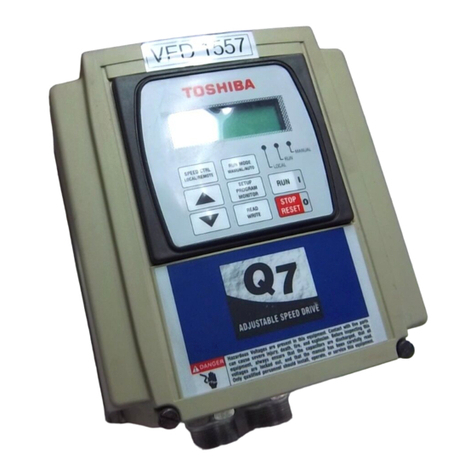
Toshiba
Toshiba Q7 Flow Installation and operation manual

Siqens
Siqens Ecoport 800 user manual
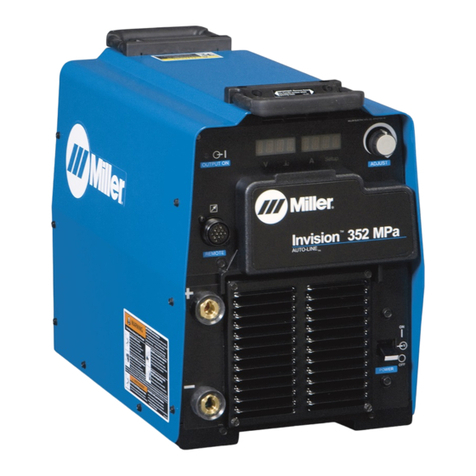
Miller
Miller Invision 352 MPa Auto-Line CE Technical manual
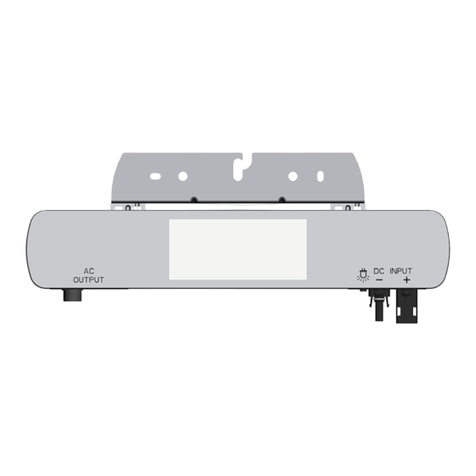
AE Conversion
AE Conversion INV315-50EU Assembly and operating instructions
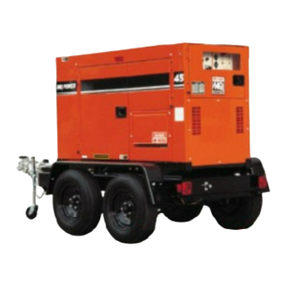
MULTIQUIP
MULTIQUIP WHISPERWATT DCA-45SSIU3 Operation and parts manual
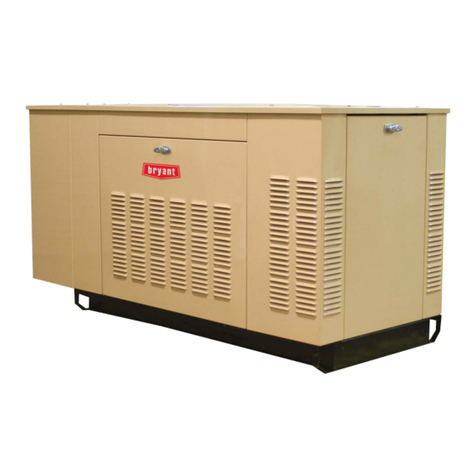
Bryant
Bryant ASPAS1BBL025 owner's manual

